
Overview North American utilities participating in the 2006 study of protective relay usage and trends account for more than 30% of all North American electricity customers and industry revenues, exceeding the participation levels in four earlier studies conducted over the past decade.
The number of North American utility protection and control engineers and engineering managers participating in the Newton-Evans protective relay study series continued to increase from a total of 64 utilities in 1999, to 79 utilities in the 2002 study, to 102 utilities in the 2004 study and this year, up to 112 utilities.
Average Percentage of Digital Relays in Installed Base and Planned for New and Retrofit Applications Purchases:
The 2006 survey has found that from 31% (bus differential relays) to 65% (small generator relays) of the installed base of protective relays in U.S. utilities is now comprised of digital relays.Percentages of new purchases tend to be dominated by digital purchases; however, significant opportunity exists in North America for electro-mechanical units, with from two percent to 18% of some units still being bought as electromechanical units.Almost all new motor protection relays planned for purchase (98%) are likely to be digital; this rate drops to only 82% for bus differential units.
Influence of Country of Manufacturing on Relay Purchasing Decisions:
A total of 111 utilities replied to the question: “Are your relay purchasing decisions influenced by the country of manufacture?”
Thirteen percent of the utilities indicated that they ONLY BUY from suppliers using North American manufacturing facilities.However, another 41% indicated that they prefer to buy from suppliers using North American production facilities. Forty-seven percent stated that the country of manufacture does not affect their purchasing decisions.
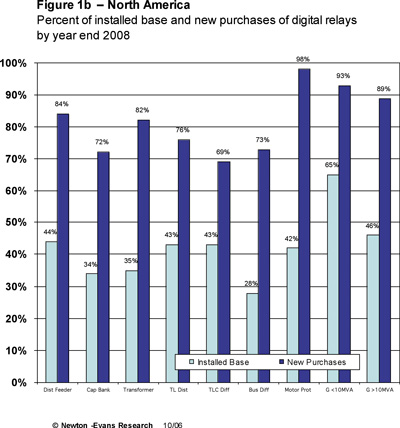
Importantly two-thirds of the cooperatives indicated strong preferences to purchase from suppliers using North American relay production facilities.
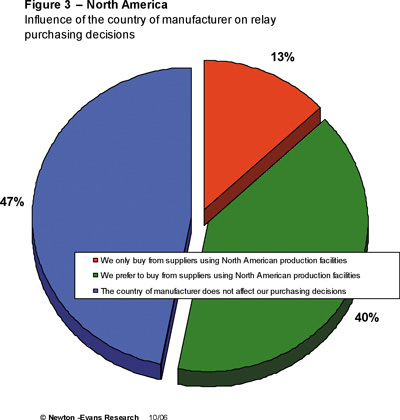
Plans to Increase Capital Investment for Relay Testing or to Increase O&M spending for Third Party Testing Services:
Respondents were requested to indicate whether they would likely be increasing capital investment for relay test equipment, or whether they would be more likely to increase spending for third party relay testing services or neither, in the 2006-2008 period.
About 75% of the responding protection engineering officials indicated that they would be likely increasing their capital investment in relay test equipment, software and training.Nearly a quarter of the survey group indicated that they would be likely to rely more heavily on third party relay testing services.Only two respondents indicated that neither approach was likely, and their was no need to increase such spending.Note that cooperative utilities were much more likely to be planning to relay more on third party testing services than were the IOU and public power utilities.
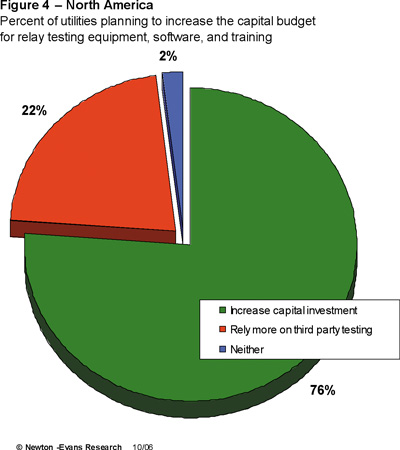
Compliance with Loading Requirements Outlined in NERC BlackoutRecommendation 8A. (Including the provisions of BZ3).
This question was expanded in the recent survey to include eight specific actions that could be taken to comply with NERC loading requirements per recommendations 8A and BZ3.
The optional responses included these:reset the zone x impedance relays; reset the transformer overload- overcurrent relays; install new protection with an integral “load encroachment” function; eliminate the transformer overload/overcurrent relays; reset the transmission line “switch on to fault” relays; add separate load encroachment blinders; eliminate the transmission line “switch on to fault” relays; request exemption; or take some other action.
Responses from 93 utilities, including some who had selected multiple action being planned to attain compliance with NERC recommendations, were quite mixed with 50 respondents (54%) indicating they will comply by “re-setting the zone x impedance relays.”Twenty-nine percent indicated they would “install new protection with an integral ‘load encroachment’ function.”Twenty-two respondents (24%) stated that they would reset the transformer overload/overcurrent relays; Seventeen percent would “reset the transmission line “switch on to fault” relays.
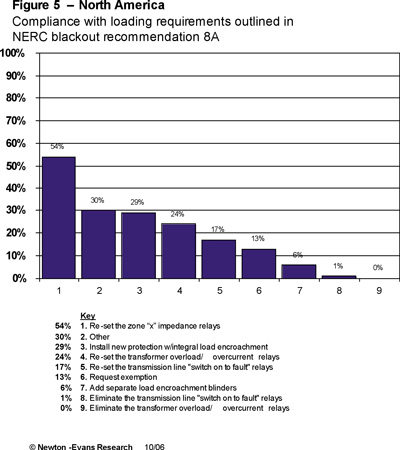
Only six percent stated that they would add separate load encroachment blinders while one utility would eliminate the transmission line “switch on to fault” relays.Officials at IOUs were much more likely to use a variety of methods to attain compliance with NERC recommendations.Cooperative utility officials were more likely to plan to request exemptions from the NERC loading requirements.
Requirements for Various Communications Media in Transmission of Relay Data:
A. Protection Communications:
The study has found that for transmission line applications the use of fiber is vital, and for line distance relays, power line carrier and microwave are also important media. Protection communications are not likely to be used for the majority of distribution feeder, transformer and capacitor bank types of relays.
The use of wireless communications is picking up, based on the findings reported in the current study, with 15 utilities now reporting some use of wireless approaches to provide protection communications for distribution feeder relays and for transmission line distance units.he majority of bus differential, motor protection, and generator relays also reportedly do not make use of protection communications media.
B. Physical Connections for Relays:
The mid-2006 study has found that copper remains the most important method of physical connection for protective relays.Note that fiber deployment continues to increase over earlier studies.The use of fiber for transmission line current differential relays has overtaken the use of copper among this survey group.Wireless connections are also on the upswing as reported by the utility respondents to this year’s survey.
C. Relay Network Topology:
In the mid-2006 study, the use of STAR topology (RS 232) remains the more vital approach for most of the listed types of relays, however the use of multidrop (RS 485 and RS 422) appears to be increasing.At least 14 of the utilities were using both approaches for distribution feeder relays, and several using both network topologies for the other relays types as well.
D. Relay Protocols in Use:
By mid-2006, the use of DNP 3 had retained its top position as the current protocol “most likely” to be used for each of the nine relay types (by application) .Proprietary protocols were next in importance, followed by Modbus and Modbus Plus.There was MINIMAL USE of IEC 61850 by mid-2006 and NO USE of IEC 60870-5.
E. Mentions of Additional Protocols to be used in the Future:
Plans for protocol changes by year-end 2008 were minimal.Users of DNP plan to “hold onto this protocol” and for the protocol to remain dominant, with some migration expected over to IEC 61850 for a number of relay types..
In Newton-Evans’ opinion, most of the changes are likely to occur at the expense of proprietary protocols, not from erosion of DNP use.These respondents will likely leapfrog from proprietary protocols directly to IEC 61850, but that is not yet clear.See Table 10E-1.
Plans to Embrace IEC 61850:
In the mid-2006 study, utility protection and control officials were requested to indicate whether their utility had already or was planning to embrace IEC 61850 in the near future.If not, the reasons for not moving to use of the IEC protocol was requested.
A total of 17 officials indicated that their utility had plans to embrace the IEC 61850 protocol in the near future, and seven others indicated that their utility had already done so.However, 86 officials indicated that they were not likely to embrace the IEC protocol for one or more reasons.The reasons given included:37officials indicated that they would continue to use currently implemented protocols; 24 who stated that “the advantages of moving to IEC 61850 were “not that great.”Twenty officials stated their belief that “some vendors have not implemented the protocol” and another 19 officials provided other reasons for not having plans to move to IEC 61850.
Reasons behind the Decision to Move to IEC 61850:
There were 24 eligible utilities to reply to this portion of question 11 combining users of IEC 61850 with those planning to migrate to IEC 61850.Seventeen of the 24 officials responded with the statement that the protocol simply offered “greater flexibility.”Sixteen of the 23 replied that one reason for their decision to move to or plan to migrate to IEC 61850 was premised on the “single protocol/tool to setup for multiple vendor products” while 12 cited the “cost reduction and faster substation configuration.” Five others cited “ease of implementation of the protocol.”
Application Plans for Wide Area Measurement Systems:
The mid-2006 study has found that there has been a significant increase in the percentage of utilities that either use or have plans to incorporate use for wide area measurement systems such as phasor measurement units (PMUs), remedial action schemes (RAS) or special protection systems (SPS).
Sixteen percent of the respondents indicated having plans for wide area measurement systems in the new study, and another 24% were uncertain about such plans. Fifty-nine percent have no use and no plans to use WAMS. A total of 43% of IOUs indicated having plans to include WAMS in their protection and control strategies. This compares with a lower respondent percentage from the 50 public power and cooperative utilities replying.
In 2004, plans for wide area measurement systems for use with phasor measurement units (PMUs) and remedial action schemes (RAS) had been somewhat limited.Nearly two-thirds of the 101 respondents to this question then indicated that they had no plans for use of wide area measurement systems.
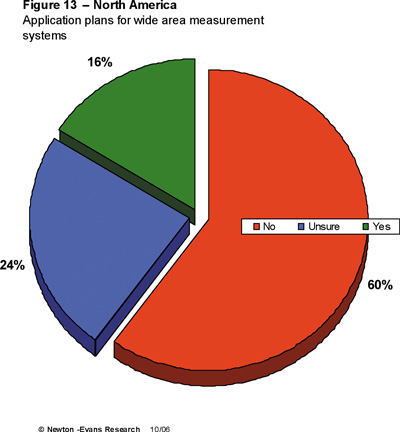
Ranking Present Day Challenges to Protection Engineering Organizations:
Senior protection and control managers and staff were asked to rank the current challenges of their utility in priority order.The optional responses included these:
Among this group of utility engineering officials, “aging infrastructure and retrofit schedules” posed the greatest present day challenge to their electric utility operations.
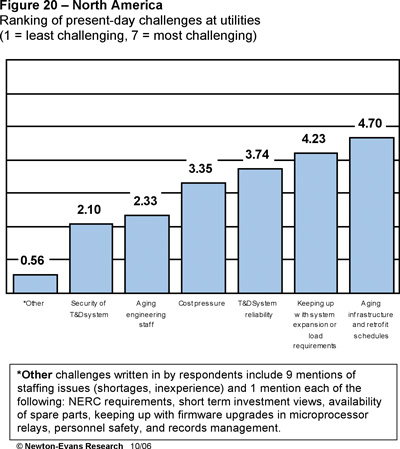
“Keeping up with system expansion or load requirements was second in importance was next, “T&D system reliability” was third, followed by “cost pressure.”
Despite the many recent articles published on this topic, “Aging engineering staff” was not highly ranked as an important present day challenge and neither was “security of the T&D system.”.
About the Author
Charles W. Newton is the President of Newton-Evans Research Company, a Maryland-based researcher of technology trends affecting the world’s electric, gas and water utilities and energy pipelines. His company has been actively researching global power and energy automation and communications markets on a proprietary and multi-client basis for 28 years.Clients include major suppliers, utilities and consultants active in automation, instrumentation and real-time computer operations (EMS/SCADA/DMS) segments of electric power and gas/oil transmission and distribution. The company also researches T&D infrastructure markets on an ongoing, proprietary basis.
Mr. Newton received an MBA in Marketing from Loyola College in Maryland and a BA degree in Economics from Fordham University in New York City.Chuck’s professional memberships include CIGRE, IEEE Power Engineering Society, ENTELEC, UTC, AMRA, AWWA, AMA, CASRO and others.
The company’s own newsletter, Market Trends Digest, is read by more than five thousand energy industry leaders each quarter.







